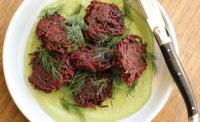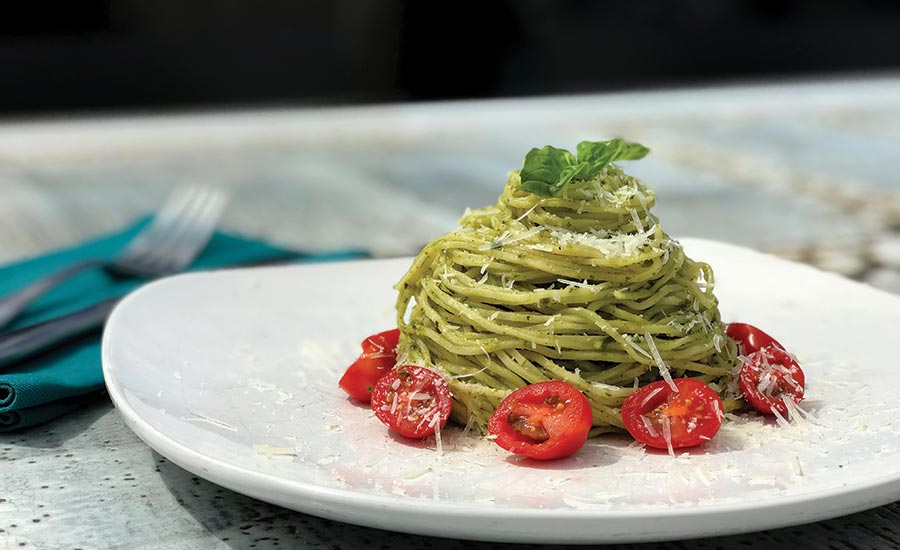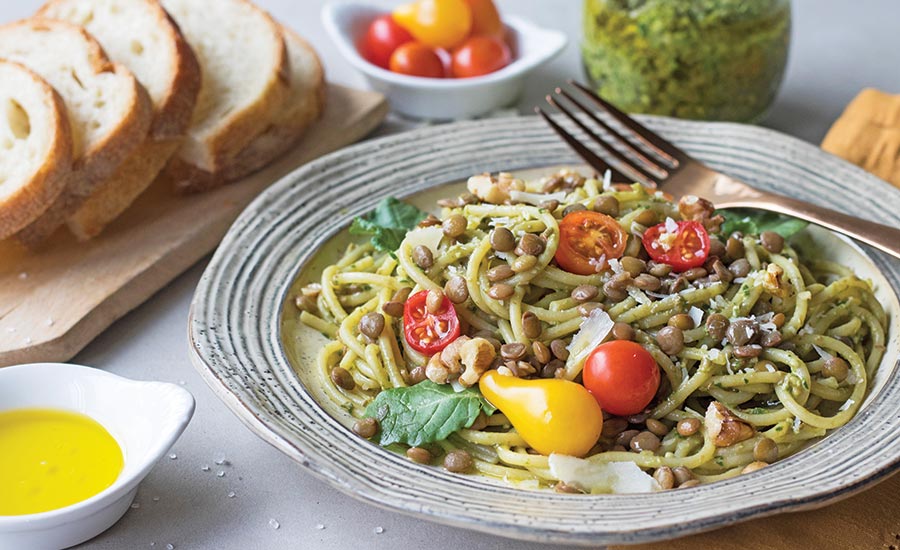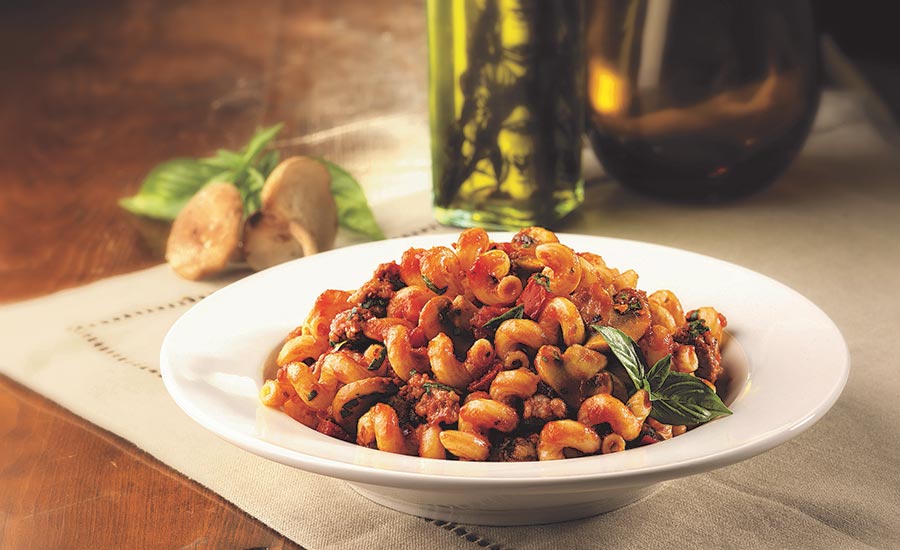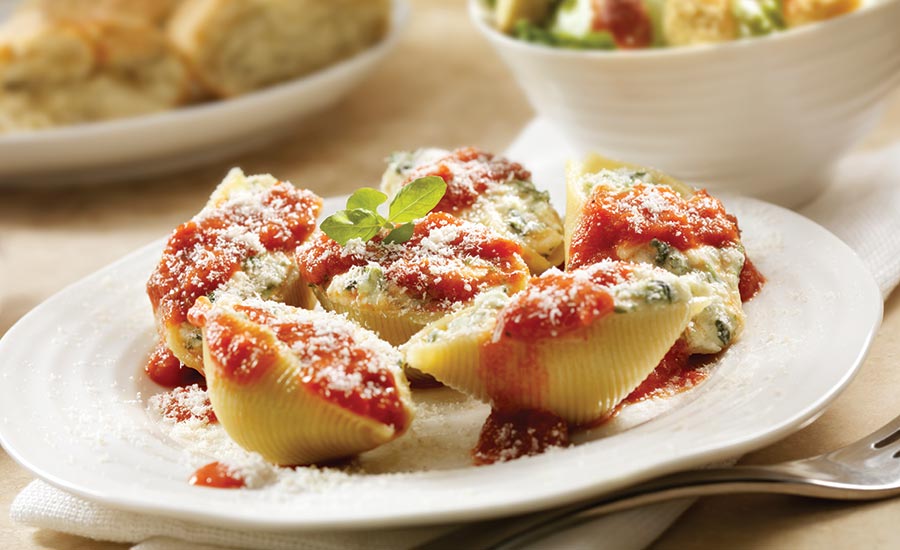Pasta Makers Are Using Their Noodles to Excite a New Generation of Consumers
Pasta Pasta!

PHOTO COURTESY OF: Carso’s Pasta Co. (www.carsospasta.com)

To serve the gluten-free trend, pasta makers have developed a plethora of noodle formulations, shapes, sauces, and meals that keep reimagining the old comfort favorite.
PHOTO COURTESY OF: Barilla America Inc. (www.barilla.com)

Combining pasta with legumes such as peas, beans, or lentils makes a formulation that provides a complete complement of plant proteins.
PHOTO COURTESY OF: US Dry Pea & Lentil Council (www.usapulses.org)

Let the shape of the pasta determine the type of sauce it holds.
PHOTO COURTESY OF: Barilla America Inc. (www.barilla.com)

Creative takes on pasta finding their way into production include ingredients such as heirloom produce, “culinary fusions,” and unusual pairings, such as fruit with soft-ripened cheese.
PHOTO COURTESY OF: Carso’s Pasta Co. (www.carsospasta.com)

Asian Noodles incorporate many naturally gluten-free versions.
PHOTO: Jonathon Sawyer/Trentina Pasta Lab (www.restauranttrentina.com)

Large, open pasta shapes such as jumbo shells are easy to hand-fill in a production environment, streamlining the manufacture of artisanal stuffed pastas.
PHOTO COURTESY OF: Cargill Inc. (www.cargill.com)







Pasta is one of the few dishes that weathers any storm of shifting trends. On the American dinner table—and those of many other nations—there always seems to be room for pasta. According to recent data from The Nielsen Company, the pasta industry continues to see gains in global pasta sales. The International Pasta Organisation (IPO) reports that the ongoing increase is driven in part by consumer attention to health and sustainability trends. As noted by Nielsen, worldwide pasta sales were up for the second year in a row in 2017, following an increase in 2016.
“This positive momentum is influenced by consumer attitudes showing an increased interest in wellness, and a sustainable approach to eating,” noted the IPO in a recent report, adding, “As a plant-based food, pasta has an extremely low environmental impact, making it especially attractive to consumers. Another area of advantage for pasta is that it is energy dense, and easy to store and distribute.”
Paolo Barilla, president of the IPO, acknowledged these and other benefits of pasta to processors and consumers alike. Quoted in the report, Barilla said, “Consumers are rediscovering the modern benefits of traditional pasta. Pasta is increasingly appreciated and valued around the world as the center of a delicious meal with good nutrition. It is also accessible, respectful of the planet, and brings people together joyfully.”
Don't Fear the Noodle
Pasta. American consumers sometimes seem to have a love-hate relationship with all things noodle-related. On the one hand, they adore the comforting, soul-satisfying slurp of a noodle from a big bowl of broth, or the huge plate of cheesy sauce-laden macaroni to fill the belly. On the other hand, pasta is associated with a high-carbohydrate lifestyle.
While shunning carbohydrates has abated somewhat, carbohydrates still get most of the blame for the obesity epidemic. Results of a prospective study recently published in British Medical Journal Open suggest otherwise. Pasta sits low on the glycemic index, which means its carbohydrates are released more slowly into the bloodstream and create smaller increases in blood sugar levels than those foods with a high glycemic index.
In the study, the researchers examined 32 randomized controlled trials involving 2,448 participants with a median age of 50 and a median body mass index (BMI) of 30.4 who ate pasta as their source of carbohydrates in a healthy, low-glycemic diet. In 21 of the trials, the tests included participants who were overweight or obese.
The participants involved in the clinical trials ate, on average, 3.3 half-cup servings of pasta each week. Participants lost a negligible average of 1lb. and saw a BMI drop of .26 kg over the course of 12 weeks.
The study’s authors concluded that pasta doesn’t contribute to an increase in weight or body fat, since participants actually experienced some weight loss (albeit not significant). This is only one among a spate of recent studies establishing that the “pasta will make you fat” myth is just that.The authors were quick to point out that the study’s results are limited to pasta consumed along with other low-glycemic foods as part of a specifically designed low-glycemic index diet. They warn that additional research is needed to determine if results extend to other healthy diets including pasta.
Whether noodles were invented in China and brought to Italy by Marco Polo, or invented in Rome more than 1,000 years before that, their popularity was instantaneous and immortal. While pasta is so closely associated with Italian cuisine—and indeed, the Italians are the world’s largest per-capita noodle consumers—the US is the largest pasta market. Americans slurp down about 2.7 million tons of pasta every year, according to data from the National Pasta Assn.
But it’s not all semolina noodles. The unabated rise in popularity of Asian noodle dishes is forecast to continue at least well into the 2020s. In its latest report on the category, Questale Market Research projected, “The Global Rice Noodle Sales category will continue to rise at a significantly higher rate than overall,” indicating rates between 20-45%, depending on the region.
The category of instant noodles, which every college ramen survivor knows ignited the market in the US a few decades ago, remains a strong center of Asian-style pasta’s popularity. According to the World Instant Noodle Assn., sales of this ultra-convenient form of pasta meal have been hovering around 100 billion units per year.
With the rise of gluten-intolerant consumers, traditional wheat-based pasta takes a second hit because of its high gluten content. While only about 4 million Americans have received a medical diagnosis requiring them to avoid gluten, the gluten-free industry has seen steady market growth, with an estimated growth at a CAGR of 9.3% from 2017 to 2025, according to FoodDive.com.
This leaves brand owners, developers, and food scientists left with the conundrum of meeting the demand for comforting noodle dishes that meet the dietary needs of the gluten-free segment.
Developers and scientists have met the demand for gluten-free noodles by creating pasta from a variety of alternative flours—ranging from corn to ancient grains, to pulses and peas, to konjac and yam—each of these having their own application considerations. We’re also seeing some incredible innovation in pasta shapes, with companies using 3D printers to create shapes we’ve never seen in the pasta aisle before.
A Noodle by Any Other Name
Pasta manufacturers have found that several heritage grains, including quinoa, kamut, maize, and buckwheat, make exceptional noodles with as much firmness and bounce as their wheat counterparts. Andean Dream LLC founder Ingrid Lazcano saw a need for a high-protein, allergen-free pasta that could also provide an opportunity to “give back.”
“We were determined to carve out a unique space within the quinoa products market to provide consumers with a healthy alternative to traditional pasta,” Lazcano notes. “In addition to that drive was our connecting with a Bolivian quinoa supplier who had obtained an organic certification for 280 indigenous farming families. He became my dedicated supplier for this ‘superfood’.”
Lazcano points out that, in addition to helping farmers, she found an opportunity to improve the lives of single mothers and individuals with disabilities by identifying a local manufacturer who employs those individuals. Andean Dream’s quinoa pasta is a vegan, gluten-free product, and completely allergen-free with no dairy, eggs, soy, or corn. It contains 20g protein per 8-oz box.
Andean Dream’s pasta cooks up with a firm al denté texture and is reported to have a flavor similar to semolina pastas. It could help provide an easy transition from a traditional semolina-based pasta product even more effectively than a whole wheat pasta. Unlike pasta made from pulse or bean flours, which can have off flavors that require masking, pasta made from quinoa and other ancient grains can have a clean flavor closer to that of standard pasta.
Cut! And, print!
By Jacqueline Delgado

PHOTO COURTESY OF: BluRhapsody/ Barilla Group SpA (www.blurhapsody.com)
The process of mixing flour and water or eggs, and extruding the resulting dough through a die or press, has been around for hundreds of years. Today, technology is transforming this category using something that, even as recently as five years ago, all but the most avant garde chefs might not have thought to employ: the 3D printer. With a 3D printer, a pasta maker can extrude dough in intricate patterns limited only by imagination and gravity.
Under the BluRhapsody name, Blu1877 SRL, a venture by the Barilla Group SpA, is crafting pasta designs that surprise both the eye and the palate. BluRhapsody’s prototype 3D printer utilizes a pasta design concept created in a computer-aided-design (CAD) program. From there, the printer is loaded with dough-filled cartridges that extrude tiny lines in concentric layers at ambient temperatures. The final product is a work of art rendered in pasta, made possible by these extraordinary advances in technology and 3D printing.
In development for about five years. BluRhapsody began as an experiment in innovation to see if it was indeed possible to create 3D-printed pasta. The first prototypes were developed in partnership with TNO, a Dutch engineering and design firm with expertise in 3D printing.
Pasta shapes are created using a CAD program to build them and, as long as the shape will stand up during printing, it can be made. The main benefit of 3D-printed pasta is of the vast potential it offers for creativity, artistry, and personalization. While pasta remains an excellent carrier and platform for flavor exploration, it’s been made the same way, by hand and extrusion, for centuries. 3D printing technology opens the door to an entirely new field of unique combinations of visual, textural, flavor, and ingredient possibilities.
Superficially, it can be argued that all pasta shapes are 3D. But due to the nature of extrusion, they are not necessarily true three-dimensional shapes. Rather, they are two-dimensional shapes extended—or extruded, if you will—into three dimensions. From the visual standpoint, 3D pasta shapes will almost always be much more striking, artful, and different from what is available commercially.
Taking BluRhapsody’s vortipa shape pasta as an example, the star-shaped pasta with multiple points begins with one large star and becomes narrower and taller with each additional star pasta layer. That cannot be achieved through extrusion. The pasta performs and tastes like fresh pasta and, in the case of the vortipa, it’s a thicker-textured cut so the al dente resilience and flavor of the pasta come through.
The dough used to make 3D pasta is comprised of the same ingredients as a standard wheat pasta — durum wheat, semolina, and water. However, BluRhapsody is not limited to a single formulation. As with traditional pasta products, other ingredients can be incorporated into the dough to add color and flavor.
As it moves into production phases, the BluRhapsody project is first finding a home with exclusive, high-end customers and chefs seeking a “one-of-a-kind” culinary expression. While for now, the cost of the technology makes it unlikely that restaurant kitchens or home counters will find the system feasible to own and maintain, the company can work with clients to create a custom shape and deliver the final product printed anywhere in the world.
As momentum and desire for this type of product builds, the market and availability could expand to other chefs and their interested clientele. BluRhapsody plans to continue exploring commercialization prospects for 3D pasta.
Jacqueline Delgado is director of business development for Blu1877, an innovation company under the Barilla Group SpA umbrella. For more information, please visit: www.blurhapsody.com.
Matching Wheat
Although texture and flavor are similar, developers could find that pastas made with alternative flours and ingredients cook up differently than their semolina counterparts. Quinoa pasta, for example, takes longer to cook than semolina pasta. Andean Dream advises preparers to cook the pasta for 15 to 17 minutes, or about twice as long as a traditional dry pasta. Rinsing the cooked noodles in cold water prior to saucing also is advised.
Beans and other legumes are finding their way into pastas more frequently. Driving this are both the gluten-free trend and the plant protein trend. Chickpea flour has proven a good substitute for wheat flour in a number of pasta formulations. In texture, taste, and color, it compares well with wheat pastas. New milling and processing techniques have even allowed for a chickpea flour that is as white as white wheat flour, suitable for lighter colored noodles.
Pea flour has been used in noodle making for years, with both strong success and strong consumer acceptance. Pea pastas can boast good fiber levels for added health cachet and meet demands for pasta products that are high in plant protein, allergen-free, and non-GMO. Although some pea flour sources can impart a slight leguminous flavor, suppliers can work with processors to ensure clean flavor profiles and answer texture and performance needs.
At Carso’s Pasta Co., alternative ingredients get a consumer-friendly positioning. “When we developed our vegan pasta, we didn’t want ‘egg substitute’ on the label,” says Dave Brown, company founder. “We experimented with different products until we found that tofu worked great as an egg replacer in our pasta. People know it and that’s what works for us.”
While new and alternative pasta formulations are driving considerable innovation in the category, consumers also are demanding greater transparency. Luckily, a number of pasta makers are discovering that business as usual fits nicely into the clean label trend.
This is especially true at Carso’s. For example, the company takes a unique approach to crafting colored noodles. “Spinach and beet powder are great for coloring water but not so good for an attractive or flavorful pasta,” says Brown.
Instead, the company cooks its own vegetables and mixes them straight into the dough. “You get nice bright spinach pasta that tastes like spinach,” says Brown. He asserts that such attention to detail has been the key to the success of Carso’s product line, adding that while he is aware of what consumers are asking for, his company just “keeps doing what we do, which is to make the best food with simple ingredients.”
In moving from bench to batch, all products have their challenges. Pasta is no exception. While fresh is likely the easiest form to use, it does come with its set of challenges. “Obviously, shelf life is shorter but using fresh is easier—you just give it a quick blanch,” explains Brown. “When used in soups or finished dishes, sometimes the blanch is really just a quick dunk.”
According to Brown, some fresh product can go directly into a finished dish—as Carso’s does with its lasagna. “We don’t have to do anything to the sheets,” he says. “We can layer them in the pan, cover, freeze, and ship. The customer cooks the lasagna and the results are perfect.”
Some facilities don’t have the capacity to receive and store hundreds of pounds of fresh product. This is where par-cooked, pasteurized, IQF, and dry products come in. The dry product is a boon for those facilities with ample dry storage.
On the other hand, it adds cook time to the processing floor, high water usage, and the need for personnel who can ensure the product is properly seasoned and cooked. In addition, the requirement of quick shocking in cold water to stop cooking and remove added starch introduces another opportunity for error.
However, dry pasta can be the food manufacturer’s cost-effective best friend when a consistent method of processing is established. For facilities that don’t have the luxury of cooking fresh, fresh-frozen, or dry pasta products, pasteurized and par-cooked noodles are readily available.
Par-cooked noodles can be a satisfying “middle ground” solution to the “fresh or dry” conundrum. In fact, some par-cooked noodles are available pre-seasoned to the customer’s specs. This adds a level of consistency control that scratch-cooked products seldom meet. These products often need nothing more than an overnight “slack” in cold storage before further processing.
Worldwide Pasta
The average American consumes nearly 9kg of pasta annually. But that’s nowhere near the top of the spaghetti heap. According to International Pasta Organisation data, “Italians are by far the greatest pasta consumers, with a per capita consumption of 23.5 kg, 1.4 million tons in total. Next in line: Tunisia (17kg), Venezuela (12kg), Greece (11.1kg), Chile (9.4kg) with Argentina, Turkey and Iran all around 8.7-8.5kg per capita, followed by Portugal and the Czech Republic (6.5kg). Brazilians eat 5.8kg per year, with Brazil being the third largest pasta market worldwide (1.2 million tons).”
Saucy Thoughts
Consumers’ sauce cravings are following the same lines as their pasta needs: healthful, clean-label, simple, fresh, artisanal. All these “buzzwords” are driving sauce innovations. Carso’s is meeting sauce trends with the same approach it takes with noodles. The company has made simple switches to “natural, healthful ingredients” to expand its success. The company’s cream sauces, for example, are made with yogurt instead of butter and cream.
Carso’s also makes its sauces by hand, in small-batch kettles. “We believe the human touch is very important,” says Brown. Carso’s chefs combat seasonality and crop fluctuations through comprehensive training programs to monitor the product and adjust formulas to ensure consistency.
Artisanal and specialty ingredients once reserved for restaurant chefs are finding their way into grocery shelf sauces with greater regularity. Truffles, porcini mushrooms, aged cheeses, and bespoke wines are both meeting and building new levels of consumer expectation. In addition to a reduction of sugar and salt, consumers are seeking fresh or IQF herbs; heirloom or breed-specific tomatoes, mushrooms, and other produce; and the elimination of fillers, additives, preservatives, or other ingredients that seem “unnatural.”
Worlds of Pasta
Crossing borders to create multi-ethnic dishes is another way developers are bringing fresh ideas to the pasta category. It’s an easy move. After all, Italy is not the only country that boasts a rich noodle heritage, and the neutral flavor of pasta makes it a perfect foil for a variety of ethnic cuisines.
Simple changes, such as adding a blend of spicy seasonings to an Alfredo sauce, take it from Northern Italy to Cajun country. Add some andouille sausage and you have a comforting, familiar dining experience that’s inventive and exciting at the same time.
Stuff It
The appeal of a little pillow of pasta stuffed with a delicious filling is undeniable. The shape of the moment? If you ask the food trend spotters at GrubStreet, top chefs are rushing to put their stamp on a candy wrapper-like stuffed pasta called carmelle. It is playful on the plate and easy to assemble.
When a formulation calls for making hundreds of an item by hand, simplicity is key. Chefs prize carmelle’s simple shape because the pasta-to-filling ratio is deemed ideal, with the perfect amount of filling enveloped in a thin but sturdy sheath of pasta. Since a lot of stuffed pasta shapes involve a multitude of folds and crimping, those that are easy to execute tend to be the shapes with staying power.
For the developer, choice of a stuffed pasta shape is usually a simple as what tooling is on hand (even if the only tool is hands). In a facility where production speed is paramount, simple shapes that can be stuffed and filled quickly—ravioli, mezzelune, pansotti, and the above-mentioned carmelle—are excellent options.
If budget and speed are not as critical, the consumer demand for specialty, artisanal, hand-made foods dictates exploring more unique and possibly intricate designs. Italian culinary history includes an encyclopedic collection of stuffed pasta shapes to satisfy anyone’s desires.
Stuffed pasta doesn’t have to be made like intricate precious jewels, however. Large manicotti and cannelloni, as well as conchiglie (shells), are larger, simple shapes that are relatively easy to fill in a production environment.
Packaged stuffed pasta trends are following white-tablecloth menus and pastas with specialty fillings (using such ingredients as wild game and heritage meats, or suspending whole egg yolks in ravioli) are making their way to supermarket shelves. Even consommés, broths, and savory jellies are being wrapped in farinaceous covers. More mainstream yet still creative ingredients finding their way into pasta shells include high-end specialty cheeses, heirloom produce, and unexpected combinations, such as pears and gorgonzola.
An important distinction the developer should note when formulating new stuffed pasta concepts is that traditionally, stuffed pasta is either simply sauced or not sauced at all. In many cases, a simple toss in browned butter or olive oil and garlic is all the finishing a pasta pillow will need for final dressing. To suit this, filling flavors should by nature lean toward the bold and flavorful. The fillings, and not the sauce, should carry the dish.
Originally appeared in the July, 2018 issue of Prepared Foods as Pasta Pasta!
Looking for a reprint of this article?
From high-res PDFs to custom plaques, order your copy today!



